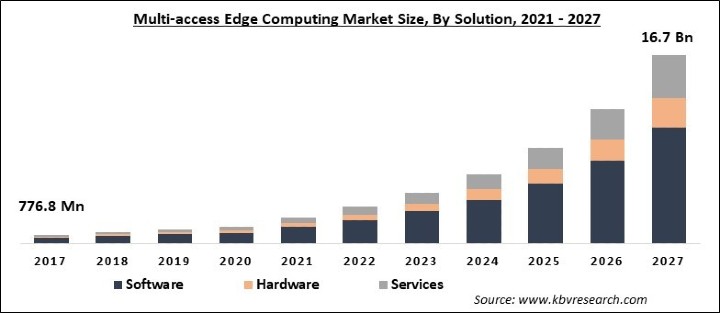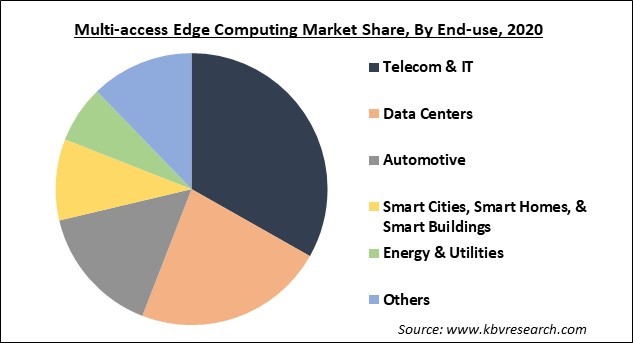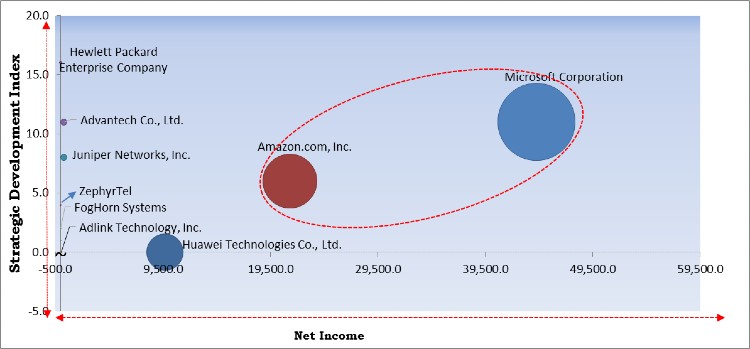
The Global Multi-access Edge Computing Market size is expected to reach $16.7 billion by 2027, rising at a market growth of 39.1% CAGR during the forecast period. Multi-access edge computing (MEC) is a part of edge computing that uses the potential of IT service and cloud computing by bringing it close to the edge of the network. The network edge is able to store, process and examine the data rather than transferring the whole data to the cloud for processing in traditional techniques. After the processing of data in the network edge keeping the customer in proximity, the produced data helps in providing real-time performance particularly, to high bandwidth applications such as Industry 4.0 and connected cars.
The environment of IT services and cloud computing holds a high bandwidth along with ultra-low latency and real-time access to Radio Network Information. Multi-access edge computing allows the software applications to get local content related to the local access network conditions, and real-time information. MEC is majorly working on the basic principle of diminishing the network crowding by directly processing data closer to the customer instead of sending it to a centralized cloud. Therefore, it offers distributed computing capabilities for holding different applications and services.

The outbreak of the COVID-19 pandemic had a negative impact on almost all industries around the world. The US and global tech market witnessed a significant slowdown in 2020 due to which, major nations like the US have lowered their investment in ICT in the first half of 2020, which is anticipated to negatively impact the growth of the multi-access edge computing market in the forecasting years. Additionally, spending on systems integration services and tech consulting witnessed a temporary slowdown.
Whereas, organizations from different industries are now recognizing the value and advantages of multi-access edge computing that would have helped them during the pandemic. Therefore, it is anticipated that several business owners will begin to scale up their digital transformation efforts and will start aggressively investing in IT and cloud resources in the coming year that will offer lucrative opportunities for the multi-access edge computing market.
MEC is excessively utilized for low-latency communication and ultra-reliable which is an important part of latency-sensitive apps and services for several companies, industrial use, and consumers. The integration of 5G services along with multi-access edge computing helps in reducing network latency and facilitating communication and performance for services like 4K video.
Augmented reality helps in merging the view of the real world and computer-generated sensory inputs like GPS data, sound & video, and graphics. It enables the user to see the real world with virtual objects superimposed upon the real world and makes the information interactive and digitally manipulable. Edge computing here is used for the generation of rendering. The processing needed is performed on edge computing rather than on the main server due to the need for high processing speed and low latency.
Edge computing offers security benefits by reducing the large volume of data to protect at data centers, but along with this, there is a concern for security at each localized point of the edge network. As not every edge device has the same built-in security and authentication abilities that make data more vulnerable to breaches. In addition, the huge volume of data is difficult to be kept secured due to which, security challenges in edge computing are high.

Based on Solution, the market is segmented into Software, Hardware and Services. The integration of various IoT devices in a multi-access edge computing-based ecosystem accelerates the demand for software, which functions and works in accordance with the existing MEC architecture. The requirement to utilize the software according to the existing environment is increasing to practice content management, distributed processing, and multi-level load-balancing, which is contributing to the growth of the software segment.
Based on End User, the market is segmented into Telecom & IT, Data Centers, Automotive, Smart Cities, Smart Homes, & Smart Buildings, Energy & Utilities, and Others. The data center segment acquired a prominent revenue share in 2020. This surge is attributed to the multi-access edge computing architecture that provided a higher degree of flexibility in the employment of datacenters. In addition, evolving trends in the employment of data centers are allowing networks and operators to leverage an agile approach to enhance infrastructures and environments that are based on a distributed architecture. Additionally, MEC-based micro data centers are anticipated to accelerate the paradigm shift in employment methods of data centers.
| Report Attribute | Details |
|---|---|
| Market size value in 2020 | USD 1.5 Billion |
| Market size forecast in 2027 | USD 16.7 Billion |
| Base Year | 2020 |
| Historical Period | 2017 to 2019 |
| Forecast Period | 2021 to 2027 |
| Revenue Growth Rate | CAGR of 39.1% from 2021 to 2027 |
| Number of Pages | 206 |
| Number of Tables | 293 |
| Report coverage | Market Trends, Revenue Estimation and Forecast, Segmentation Analysis, Regional and Country Breakdown, Competitive Landscape, Companies Strategic Developments, Company Profiling |
| Segments covered | Solution, End User, Region |
| Country scope | US, Canada, Mexico, Germany, UK, France, Russia, Spain, Italy, China, Japan, India, South Korea, Singapore, Malaysia, Brazil, Argentina, UAE, Saudi Arabia, South Africa, Nigeria |
| Growth Drivers |
|
| Restraints |
|
Based on Regions, the market is segmented into North America, Europe, Asia Pacific, and Latin America, Middle East & Africa. Asia-Pacific holds a prominent market share in 2020. Organizations in this region are providing the integrated functionality of edge computing solutions & cloud computing expand MEC architecture for commercial services. Various telecom companies like China Telecom Corporation Limited, SK Telecom Corporation, China Mobile Limited, Ltd. in South Korea, and China Unicom (Hong Kong) Limited are deploying edge centers in this region. These organizations are looking forward to constructing large-scale edge-cloud networks and are involved in MEC trial projects.
Free Valuable Insights: Global Multi-access Edge Computing Market size to reach USD 16.7 Billion by 2027

The major strategies followed by the market participants are Partnerships. Based on the Analysis presented in the Cardinal matrix; Amazon.com, Inc. and Microsoft Corporation are the forerunners in the Multi-access Edge Computing Market. Companies such as Hewlett Packard Enterprise Company, Juniper Networks, Inc., ZephyrTel are some of the key innovators in the market.
The market research report covers the analysis of key stake holders of the market. Key companies profiled in the report include Hewlett Packard Enterprise Company, Juniper Networks, Inc., Huawei Technologies Co., Ltd., Amazon.com, Inc., Microsoft Corporation, Adlink Technology, Inc., Advantech Co., Ltd., ZephyrTel, FogHorn Systems and SMART Embedded Computing.
By Solution
By End User
By Geography
Companies Profiled
The global multi-access edge computing market size is expected to reach $16.7 billion by 2027.
Rising need for improvement in augmented and virtual reality (AR/VR) are driving the market in coming years, however, difficult to prevent and monitor security breaches limited the growth of the market.
Hewlett Packard Enterprise Company, Juniper Networks, Inc., Huawei Technologies Co., Ltd., Amazon.com, Inc., Microsoft Corporation, Adlink Technology, Inc., Advantech Co., Ltd., ZephyrTel, FogHorn Systems and SMART Embedded Computing.
Organizations from different industries are now recognizing the value and advantages of multi-access edge computing that would have helped them during the pandemic.
The IT and telecom segment hold the maximum market share in 2020. The commercial launch of the 5G delivery system provides clients to experience efficient transfer & analysis of large volume data.
The North America dominated the market by acquiring the largest revenue share in 2020. The various strategic initiatives like the 5G FAST PLAN were taken by the Federal Communications Commission (FCC) to increase 5G deployment in the US.
Our team of dedicated experts can provide you with attractive expansion opportunities for your business.
